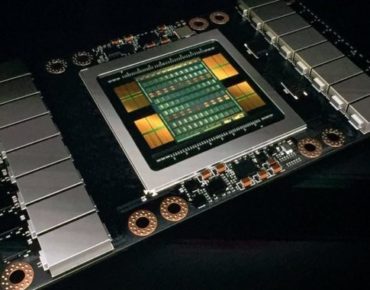Nvidia, Partners Announce Several V100 Servers

Here come the Volta 100-based servers. Nvidia today announced an impressive line-up of servers from major partners – Dell EMC, Hewlett Packard Enterprise, IBM, and Supermicro – all featuring Nvidia’s new V100 GPUs. Availability information was not immediately clear but with SC17 approaching in November it’s likely at least a few of the new servers will be on display.
The V100, of course, is Nvidia’s latest and most powerful GPU. It began shipping in quantity only recently. It is literally a whale of a chip with more than “21 billion transistors, as well as 640 Tensor Cores, the latest NVLink high-speed interconnect technology, and 900 GB/sec HBM2 DRAM to achieve 50 percent more memory bandwidth than previous generation GPUs.”
The new servers include:
- Dell EMC – The PowerEdge R740 supporting up to three V100 GPUs for PCIe, the PowerEdge R740XD supporting up to three V100 GPUs for PCIe, and the PowerEdge C4130 supporting up to four V100 GPUs for PCIe or four V100 GPUs for NVIDIA NVLink interconnect technology in an SXM2 form factor.
- HPE – HPE Apollo 6500 supporting up to eight V100 GPUs for PCIe and HPE ProLiant DL380 systems supporting up to three V100 GPUs for PCIe.
- IBM – The ‘next generation’ of IBM Power Systems servers based on the POWER9 processor will incorporate multiple V100 GPUs and take advantage of the latest generation NVLink interconnect technology — ‘featuring fast GPU-to-GPU interconnects and an industry-unique OpenPOWER CPU-to-GPU design for maximum throughput.’
- Supermicro – Products supporting the new Volta GPUs include a 7048GR-TR workstation for all-around high-performance GPU computing, 4028GR-TXRT, 4028GR-TRT and 4028GR-TR2 servers designed to handle the most demanding deep learning applications, and 1028GQ-TRT servers built for applications such as advanced analytics.
Nvidia says the V100 GPU can deliver the equivalent performance of 100 CPUs for many data intensive workloads. The variety of configurations announced by the major systems vendors should certainly accommodate a wide variety of needs and applications.
“Volta systems built by our partners will ensure that enterprises around the world can access the technology they need to accelerate their AI research and deliver powerful new AI products and services,” said Ian Buck, vice president and general manager of Accelerated Computing at Nvidia, in the official announcement.

The IBM announcement is notable for its intended use of IBM’s Power9 chip. Brad McCredie, vice president and IBM Fellow, Cognitive Systems Development at IBM, is quoted saying, “IBM’s upcoming POWER9 servers will support NVIDIA’s Volta GPU, and will be the only one to support the latest generation of NVLink and PCIe 4.0, which will deliver maximum throughput.”
McCredie posted a blog coinciding with the announcement (Proposition: No speed limit on NVIDIA Volta with rise of AI). In it he took a shot at Intel – “Intel-based systems seem to be designed for yesterday’s era of architecture: defined by determinative code, not for free-flowing data, streaming sensors and always-on algorithms” – adding, “Servers with POWER9 and Volta, with its second-generation NVIDIA NVLINK, PCI-Express 4, and Memory Coherence technologies, and unprecedented internal bandwidth, will blow people away.”
The first IBM Power9 chips as well as new acceleration technologies will be used in the U.S. Department of Energy Summit Supercomputer at the Oak Ridge National Laboratory and the Sierra Supercomputer at the Lawrence Livermore National Laboratory. There’s been anticipation that one or both of the machines may be ready in time to break into the next Top500.
Other testimonial quotes included in Nvidia’s release include:
“One of the core principles for Dell EMC is to deliver differentiated solutions to our customers so that they can leverage the most advanced technology for a competitive advantage. To that end, we are proud of the work we do with partners like NVIDIA to build PowerEdge servers ideal for compute-intensive workloads including data analytics, high-performance computing, machine learning and AI.” – Armughan Ahmad, senior vice president and general manager of Hybrid Cloud and Ready Solutions at Dell EMC
“As deep learning continues to become more pervasive, technology advancements across systems and accelerators need to evolve in order to gain intelligence from large datasets faster than ever before. The HPE Apollo 6500 and HPE ProLiant DL380 systems combine the industry-leading GPU performance of NVIDIA Tesla V100 GPU accelerators and Volta architecture with HPE unique innovations in system design and manageability to deliver unprecedented levels of performance, scale and efficiency for high performance computing and artificial intelligence applications.” – Bill Mannel, vice president and general manager of High Performance Computing and Artificial Intelligence at Hewlett Packard Enterprise
“Supermicro designs the most application-optimized GPU systems and offers the widest selection of GPU-optimized servers and workstations in the industry. Our high performance computing solutions enable deep learning, engineering and scientific fields to scale out their compute clusters to accelerate their most demanding workloads and achieve fastest time-to-results with maximum performance per watt, per square foot and per dollar. With our latest innovations incorporating the new NVIDIA V100 PCI-E and V100 SXM2 GPUs in performance-optimized 1U and 4U architectures with next-generation NVLink, our customers can accelerate their applications and innovations to help solve the world’s most complex and challenging problems.” – Charles Liang, president and CEO of Supermicro
Link to Nvidia release: http://www.marketwired.com/press-release/worlds-largest-server-companies-announce-nvidia-volta-systems-supercharged-for-ai-nasdaq-nvda-2235220.htm
Link to IBM blog: https://www.ibm.com/blogs/systems/proposition-no-speed-limit-on-nvidia-volta-with-rise-of-ai/










